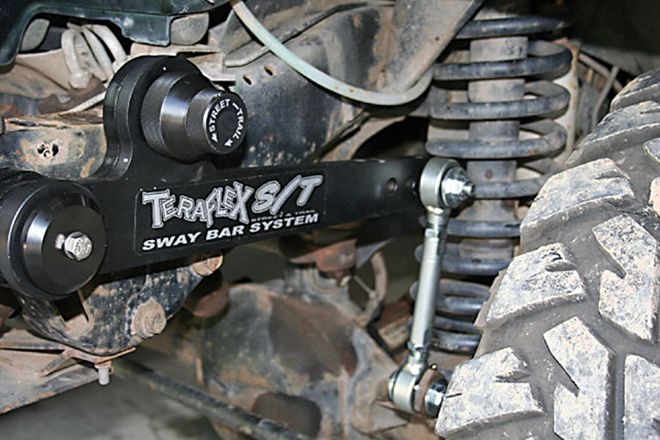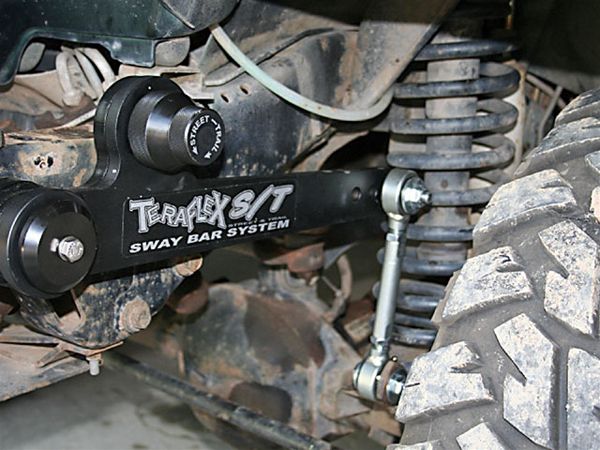
The TJ is without a doubt one of the best-handling, best-riding, and perhaps the best 4x4s Jeep has ever produced. The switch from leaf to coil springs offered many benefits besides just ride quality. For on-road travel, the sway bar is a must, such as when cornering, as the suspension load is partially transferred from the outside wheel to the inside wheel. This offers not only better handling, but a better feel of stability. There is also the plus of keeping the vehicle more stable without radical weight transfer from side to side under certain conditions.

To improve off-highway performance, the aftermarket has provided numerous methods of temporarily disconnecting a sway-bar link so the sway bar is no longer functional. Good suspension articulation is one of the key aspects when it comes to providing off-highway capabilities for a vehicle, and disconnecting the sway bar allows the suspension to flex to its maximum capacity without any inhibitions. This provides several benefits. First of these is the undisputed fact that keeping all the tires on the ground provides better traction, even with a locking differential. Second, the ability of the suspension to follow the ground contour instead of transferring the twisting to the frame, provides a longer life to not only the frame, but the body as well. But there are also times, even on off-highway excursions, when you want better control over the vehicle's suspension with the sway bar connected. One example would be when running hard down a dirt road trying to give your best Don Adams impression. While no one ever says, "Let's go run some sidehills," it does happen. Having the sway bar connected definitely makes for a much safer traverse.
A lot of times, we just won't disconnect or reconnect the sway bar when we should because, well, it's just a real pain to do. If the vehicle is not on level footing, it is nearly impossible to remove one of the link connections, and it is sometimes even more difficult when trying to hook it back up.
There has to be a better way, and perhaps Teraflex has found it with its new S/T (Street and Trail) Sway Bar System Kit.
Starting from a clean slate, they designed a new sway-bar system that mounts within the tubular front crossmembers. The sway-bar bushings are made from nylon impregnated with molybdenum bisulfide to further eliminate squeaks and provide a solid platform for the sway bar to rotate on. These bushings won't deflect under load like rubber bushings do. Unlike the factory bar, this one draws from the racing field, and instead of being one piece of bent steel rod, it is made up of a straight bar of 4130 chromoly, with rolled splines (35-spline) on the ends for superior strength. Arms of heat-treated steel are attached to the splines, and extend rearward to the connecting links. There are three different mounting locations for the links to connect to the bars, offering the opportunity for variable rates of control or link angles.
But the really neat part of this bar is in the way it disconnects. No more fighting trying to remove a link from the axle bracket and then struggling to get it back on. A unique locking mechanism is incorporated in the two-piece left-side arm that allows a large hardened-steel locking pin to engage both parts of the arm for a positive engagement. The pin has a taper to it, so that engagement is positive without any rattles. When you want the bar disconnected, you just turn the control knob clockwise until it releases one arm from the other. To re-engage the sway bar, you turn the knob counterclockwise, and a spring-loaded mechanism snaps the locking pin in place when it lines up. No more driving back and forth and getting in and out to find just the right angle for alignment of the link mount into a pin, or trying to hold up the link with a zip-tie.
Sounds good on paper, but does it really work? Sure enough, and pretty darn good. The only problem we had with it on our test TJ was that the knob was hard to turn when trying to disconnect it when one wheel was considerably higher than the other. But reconnecting it was literally a "snap." One other thing that we noted was that street handling was vastly improved with the sway bar connected. Factory rubber bushings will squirm around a bit under a load, not allowing the factory torsion bar to work at its best. This can't happen with the way the S/T sway-bar system is mounted, so even though the bar's overall effective rate isn't increased, the control is.
Now you get to stand around and gloat while others at the end of a trail ride are fighting to get their sway bars reconnected with their old-style links.